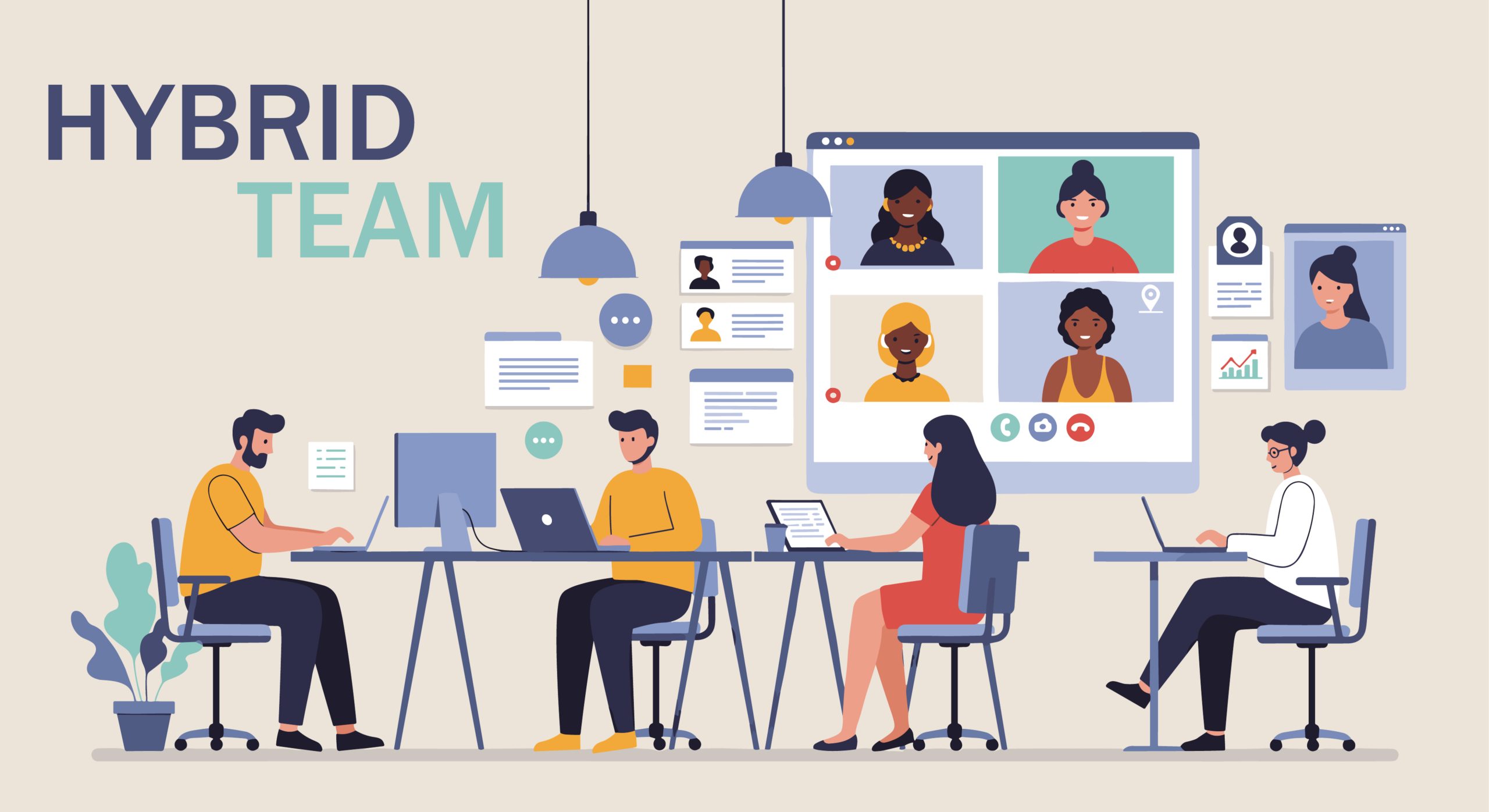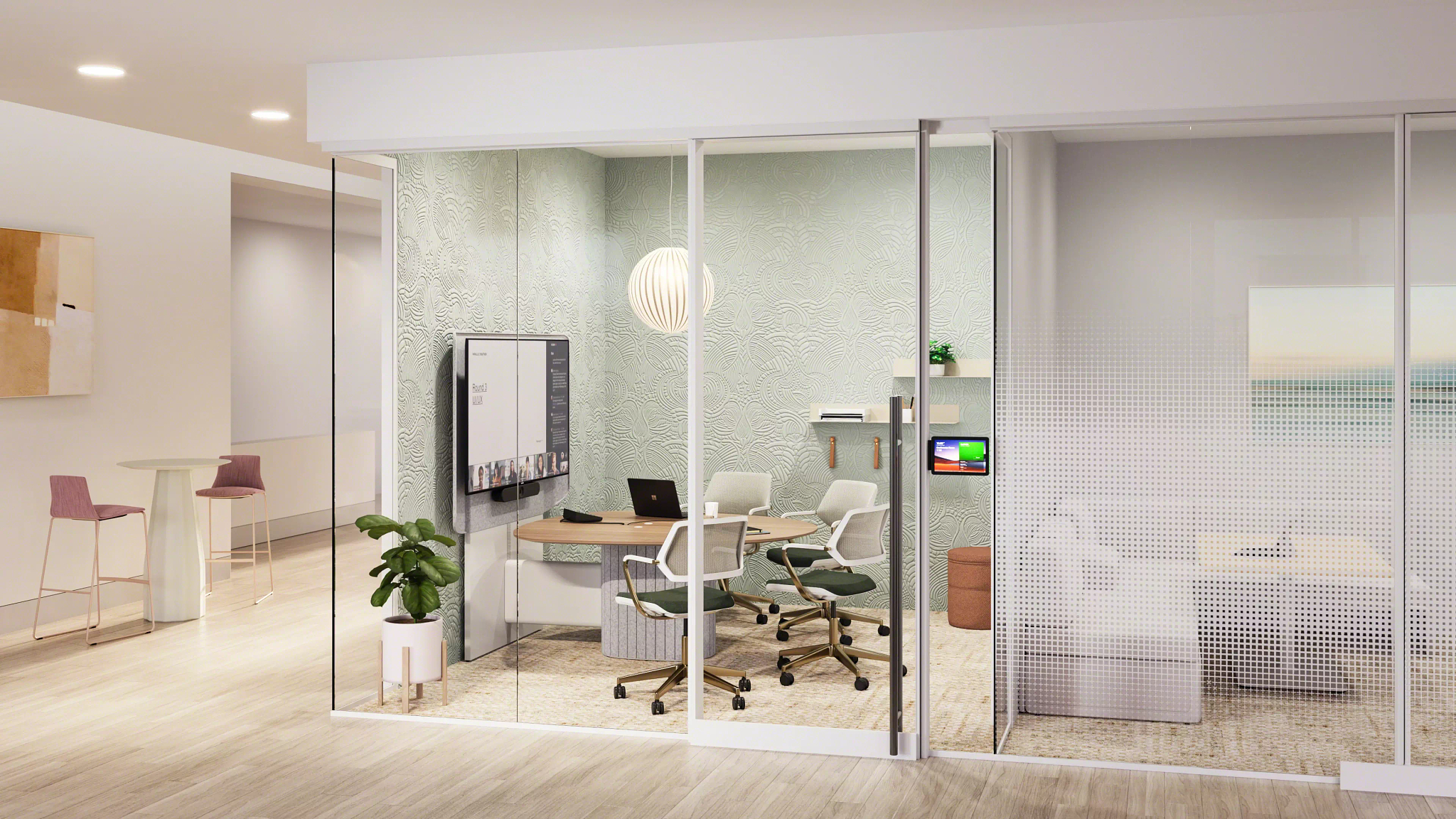We use cookies to maximize your online experience with us. By closing this window, you consent to our cookie policy. You can change your cookie settings in your browser any time. For more information, please see our Privacy Policy located on the footer of this site.
What is Visual Technology? Bringing Hybrid Communication to Life
 Hybrid work offers the best of both worlds: the flexibility to work remotely and the connectivity of face-to-face interactions. The average American hybrid worker spends 3 days in the office.
Hybrid work offers the best of both worlds: the flexibility to work remotely and the connectivity of face-to-face interactions. The average American hybrid worker spends 3 days in the office.
While this setup strikes the perfect balance, it comes with one notable challenge: a communication barrier. Engagement can easily suffer with some staff in the office and others joining virtually. The video call lags, the speaker’s voice crackles, ideas get lost, and frustration builds. Collaboration suffers.
That’s why companies turn to integrated technology solutions providers like DBE Systems, powered by dancker, to solve these challenges with cutting-edge visual technology. By combining AI-powered video conferencing, interactive displays, and smart meeting tools, DBE Systems helps businesses create seamless hybrid environments that feel as connected as in-person collaboration.
With many companies expanding their footprint beyond their local area, hybrid communication is not just for employees—now, sales and client meetings are frequently held in a virtual environment. It’s more important than ever to bridge the gap with hybrid work solutions that can engage and connect both parties toward a common goal.
Visual technology is often a key missing piece: a workspace replicating in-person meetings and making remote participants feel just as present and engaged as those in the office.
The Disruptive Digital
Studies have shown that the brain processes visuals 60,000 times faster than text and retains that content for a longer period. Imagine harnessing that power when communicating with your internal teams or prospective clients! Stunning imagery and simple graphics will not only capture and hold their attention longer, but will make the message more impactful, more memorable, and less subject to interpretation.
Here is how your businesses can harness video connectivity to strengthen collaboration and ensure no one gets left behind.
What is Visual Technology?
Visual technology refers to hardware and software tools—such as interactive displays, digital whiteboards, and video conferencing systems—that facilitate visual communication in hybrid work environments. These solutions help bridge the physical-digital divide, making remote collaboration more immersive and effective.
 The Role of Visual Technology in Hybrid Communication
The Role of Visual Technology in Hybrid Communication
Here is how visual technology is transforming hybrid collaboration:
1. Bridging the Physical and Digital Divide
The biggest challenge in hybrid work environments is the disconnect between on-site and off-site workers. It’s easier to engage with a physically present team. They can access collaboration tools like whiteboards, and you can always pick up on their body language.
Meanwhile, remote workers can get the sense of being an afterthought. They often struggle with poor sound quality in remote meetings, with many companies lacking robust audio-conferencing capabilities. This is an even bigger dilemma when meeting with potential or existing clients, with higher stakes due to meeting quality making or breaking sales.
Visual technology bridges this gap. It helps remote employees feel just as engaged as those in the office. It also gives
High-resolution interactive displays allow remote and in-office teams to interact as though they are in the same room.
Through Virtual reality (VR) and augmented reality (AR), teams create digital rooms for interactive discussions, brainstorming sessions, and product demos.
Advanced cameras with voice-tracking features ensure that remote employees can clearly see who’s speaking and follow discussions effortlessly.
2. Improves Engagement and Retention
Listening to a presentation on your screen for hours isn’t exactly inspiring. It’s easy to get bored and stop concentrating, which can lower engagement and retention.
Visual technology makes meetings more interactive by injecting life into them. Tools like digital whiteboards and live polls keep teams active. They can contribute visually instead of just listening to ideas.
Also, high-quality images and animations make complex topics easier to understand and remember. A 2-hour meeting now feels like 20 minutes.
3. Improves Productivity
Slow communication in a hybrid work environment can stall progress, leading to delays, misalignment, and frustration.
Visual communication technology helps bridge this gap by enabling teams to share ideas more clearly and efficiently.
Most visual collaboration platforms now support live chat, markup tools, and annotations, allowing teams to provide instant feedback and iterate in real time. 
Additionally, AI-driven tools can enhance these platforms by automating task assignments, highlighting key decisions, and even analyzing data from sources like spreadsheets or reports to surface actionable insights—helping teams stay aligned and move faster.
First, it sifts through endless spreadsheets to make sense of data instantly. Work that would take humans hours is completed in seconds.
Secondly, most visual collaboration platforms allow instant feedback through live chat, markup tools, and annotations. Teams can iterate and improve ideas without delays.
Finally, AI-driven tools can assign tasks automatically, highlight key decisions, and transcribe discussions, ensuring that nothing is lost after a meeting.
4. Facilitates Real-Time Collaboration
Just because you are working hybrid doesn’t mean you should wait the entire day for an email response to proceed with a project. Even worse is struggling with tools that don’t support teamwork.
Visual technology allows teams to collaborate in real-time, even when some are working remotely.
Platforms like Google Jamboard and Miro allow teams to brainstorm and sketch ideas just as they would in a physical room.
Thanks to live document editing, teams can edit files, reports, and presentations simultaneously instead of passing them back and forth.
Finally, Augmented Reality (AR) & Virtual Reality (VR) tools create immersive hybrid workspaces for teams to conduct product demos, walk through project prototypes, and even interact with 3D models in real time.
 Image Source: Pexels
Image Source: Pexels
Benefits of Investing in Visual Technology
On top of making employees work faster and smarter, these are the other benefits accrued by businesses investing in visual technology.
1. A More Inclusive Work Environment
Hybrid work should feel like an opportunity, yet it’s often more of an obstacle for many employees.
Visual technology changes this by ensuring everyone, even those halfway across the world, has an equal seat at the table.
Remote teams can see and hear everything clearly, participate in real time, and interact with team members as if they were physically present.
Distance doesn’t define participation, and visual technology just proved this.
2. Enhanced Collaboration
Progress is slow when teams are disconnected. But with a proper hybrid work environment, collaboration becomes effortless.
Tools like AI-powered meeting assistants, live document editing, and digital whiteboards ensure decisions happen faster, and ideas flow freely.
These tools literally bring everyone to the same page.
3. Improved Productivity and Efficiency
In the workplace, you want things done. And you want them done smart and fast. When communication lags, efficiency takes a hit. Meetings stretch longer than necessary and in-office and remote teams struggle to stay in sync.
Visual technology eliminates these barriers and helps teams work more effectively.
DBE Systems – A Visual Technology Solution for Hybrid Communication
At a time when most companies are all about making sales, DBE Systems remains one of the few that really considers the consumer’s needs.
Founded in 2019, DBE Systems is an integrated technology contractor powered by Dancker that works to improve business workflow and work experiences. It integrates AI-powered video conferencing, interactive displays, and smart meeting tools into hybrid setups to make communication natural and more effective.
Choosing DBE Systems for your business gives you:
- Seamless hybrid collaboration where in-office and remote teams work together in real time, just as if they were in the same space.
- Private and more comfortable workplaces with sound management and background music. It ensures the well-being of the people in your spaces.
- Improved visual presentations to make meetings exciting and impactful.
 The Smart Choice for Hybrid Teams
The Smart Choice for Hybrid Teams
Hybrid work is here to stay, but its success depends on how well we collaborate, connect, and communicate.
Visual technology bridges this gap. It improves clarity, enhances engagement, and streamlines collaborations. With hybrid solutions, remote teams don’t just function; they thrive.
Investing in integrated technology solutions can set your business up for a dynamic, seamless, and highly productive work environment where remote and in-office employees are fully engaged.
Ready to transform your hybrid workplace with cutting-edge visual technology? Contact DBE Systems, powered by Dancker, to explore customized solutions that elevate communication and collaboration.
FAQ
Q1: What is visual technology in hybrid workspaces?
A: Visual technology refers to tools like interactive displays, digital whiteboards, AR/VR systems, and video conferencing platforms that support real-time, immersive communication in hybrid work environments. These tools help bridge the gap between remote and in-office teams, making collaboration more seamless and engaging.
Q2: How does visual technology improve team productivity?
A: By enabling real-time collaboration, simplifying complex information through visuals, and supporting instant feedback and annotations, visual technology reduces delays and miscommunication. It streamlines workflows so teams can work smarter and faster, regardless of location.
Q3: Why is visual technology important for remote collaboration?
A: Remote employees often feel disconnected due to poor sound, laggy video, or lack of participation. Visual technology creates a more inclusive and interactive experience, helping remote team members stay engaged, contribute meaningfully, and feel like equal participants in meetings.
